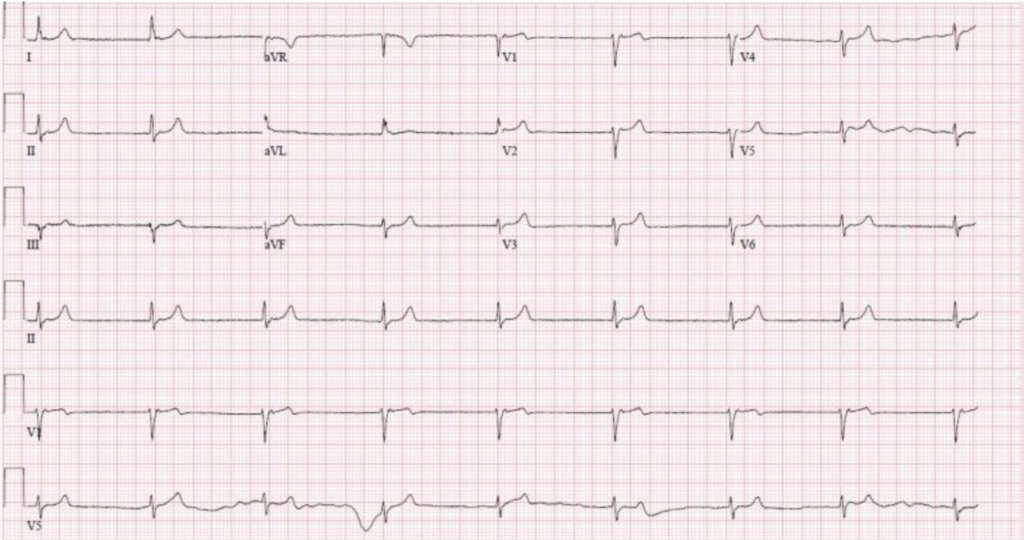Patient History
A 58-year-old male with a long-standing history of hypertension and benign prostatic hyperplasia was recently prescribed prazosin. The patient was otherwise compliant with his antihypertensive medications and had no prior history of syncope or orthostatic hypotension. He was instructed to take 1 mg of prazosin at bedtime to minimize potential side effects.
Symptoms
Within two hours of taking the first dose, the patient experienced dizziness, lightheadedness, and fainted while attempting to get out of bed.
Examination
Physical Examination
Upon examination in the emergency department:
- Blood Pressure: 90/60 mmHg (significantly reduced from his usual 140/90 mmHg)
- Heart Rate: 80 bpm
- Other Findings: The patient was alert but pale and diaphoretic. There were no signs of cardiac distress or other acute issues.
Laboratory Tests
Initial Labs
- Complete Blood Count (CBC): Normal
- Electrolytes: Normal
- Renal Function: Normal
- Blood Glucose: Normal
Additional Tests
- Electrocardiogram (ECG): Normal sinus rhythm, no signs of ischemia or arrhythmias
- Orthostatic Vital Signs: Marked drop in blood pressure upon standing, confirming orthostatic hypotension
Diagnosis
First Dose Phenomenon of Prazosin
Based on the patient’s recent initiation of prazosin, symptoms, and clinical findings, the diagnosis of the first dose phenomenon of prazosin was made. This phenomenon is characterized by pronounced hypotension after the first dose of the medication.
Introduction
Prazosin, an alpha-1 adrenergic receptor antagonist, is commonly prescribed for hypertension and conditions such as benign prostatic hyperplasia. However, its administration is often associated with a phenomenon known as the “first dose phenomenon,” which can lead to significant hypotension and syncope.
Pathophysiology
Mechanism
Prazosin blocks alpha-1 adrenergic receptors, leading to vasodilation. In patients not yet acclimated to this effect, the sudden vasodilation can result in a significant drop in blood pressure, particularly when changing from a lying to a standing position.
Management
Immediate Care
- Positioning: The patient was placed in a supine position with legs elevated to improve venous return.
- Fluid Resuscitation: Intravenous fluids were administered to help restore blood pressure.
- Monitoring: Continuous blood pressure and cardiac monitoring were initiated.
Long-Term Management
- Medication Adjustment: The dosage of prazosin was reconsidered, with plans to start at a lower dose (0.5 mg) and titrate slowly.
- Patient Education: The patient was advised on the potential for hypotensive episodes and instructed to take the medication at bedtime to minimize the risk of falls. He was also counseled on the importance of rising slowly from a sitting or lying position.
- Follow-Up: Scheduled follow-up appointments to monitor blood pressure and assess tolerance to the medication.
Prevention
Strategies to Minimize First Dose Phenomenon
- Start Low, Go Slow: Initiating treatment with the lowest possible dose and gradually increasing.
- Bedtime Dosing: Administering the first dose at bedtime to reduce the risk of symptomatic hypotension.
- Patient Education: Informing patients about the potential side effects and how to manage them.
Conclusion
The first dose phenomenon of prazosin is a significant clinical occurrence that requires careful management to prevent adverse outcomes. Through appropriate dosing strategies, patient education, and close monitoring, the risks associated with this phenomenon can be minimized, allowing patients to safely benefit from the therapeutic effects of prazosin.
